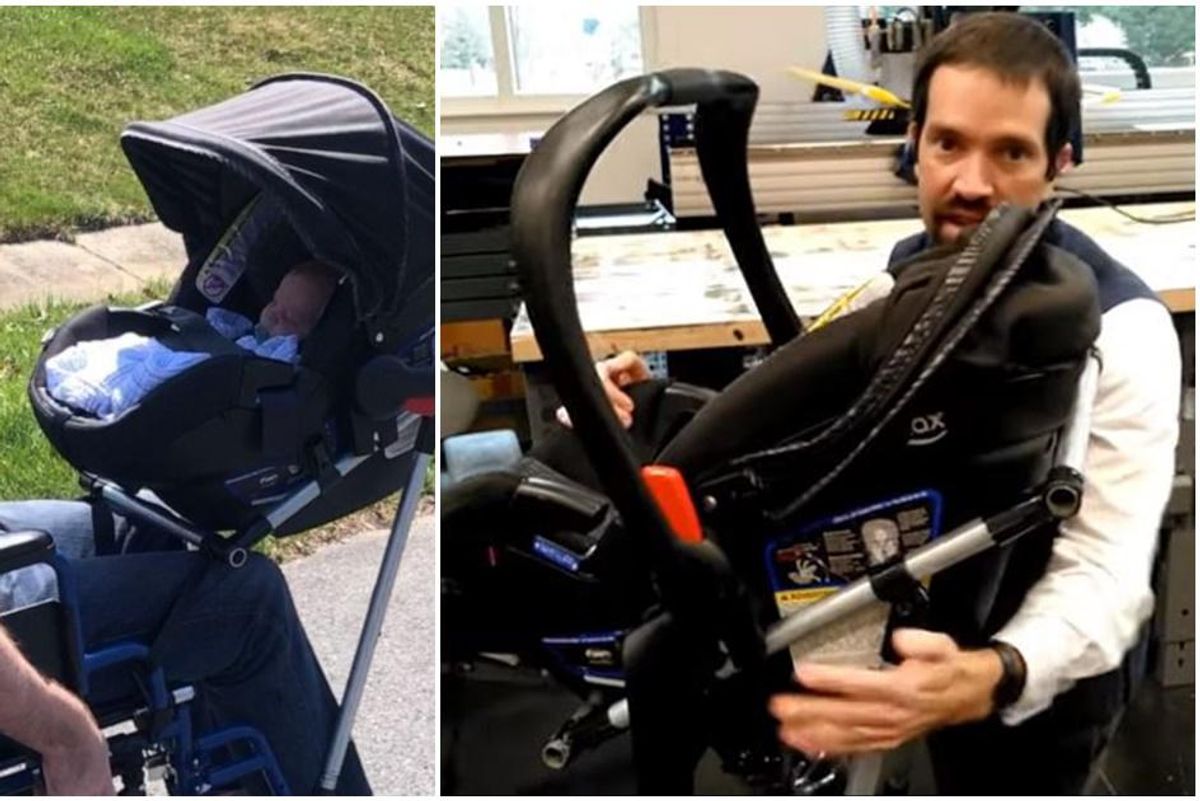Dad with impaired mobility can walk his newborn after crafty teens built him a 'wheestroll'

Three years ago, Jeremy King, 37, of Germantown, Maryland, underwent surgery for a brain tumor. He was able to walk after the procedure but still has some challenges maintaining his balance.
In June 2020, he and his wife, Chelsie, 32, learned they had a child on the way and were concerned whether Jeremy would be able to go on a walk with a newborn.
"Over the last few years we've kind of navigated his new adaptability and last summer when we found that we were expecting that introduced a whole new set of challenges," Chelsie told Today. "Parenting is hard enough, but when you have a physical disability, especially one that is still fairly new ... We immediately started researching things to find ways to make parenting accessible for Jeremy, and honestly we didn't come up with a lot."
Chelsie is a school teacher so she asked fellow educator, Matt Zigler, at Bullis School in Potomac, Maryland, if he could help.
Zigler teaches a high school class called "Making for Social Good," where students work to create products that have a positive social impact.
High School Students Create Wheelchair Stroller for Teacher's Husbandwww.youtube.com
"The idea of the course is to start out by trying to understand the problem, so we did interviews with the family," Zigler told "Good Morning America." "We talked to somebody at the local fire department who actually does infant car seat installation training to try to better understand how those things work."
Zigler asked his students to come up with ideas for a wheelchair attachment that could accommodate a car seat and then create 3D models of what they would look like. The students also got to speak with the Kings to learn about their specific challenges.
The students were even more excited about the project because they felt a special connection with the Kings. "It was a good experience to have because we could ask them questions," Ibenka Espinoza, 17, told "Good Morning America." "I think that was the most fun."
The students soon realized that a car seat attachment was only a temporary solution and that they'd need to design something that works for strollers as well. "Children grow and they grow out of a car seat so we wanted Mr. King to be able to walk with his son no matter what age he was," Jacob Zlotnitsky, 18, said.
The students used a 3D printer to make custom parts for the attachment and took several trips to Home Depot for additional materials. They also borrowed a wheelchair from the nurse's office to use as a model.
WheeStroll - Wheelchair Stroller Attachmentwww.youtube.com
The students finished both attachments in March, just before Chelsie's due date. A few weeks after the birth of their son, Phoenix, they were able to successfully use the car seat attachment to take him on walks.
"Using it was overwhelming because I never thought I would be able to do something like this with our son," Jeremy said. "Most people can go out on a walk with their family but that is really difficult for me — most people take that for granted."
Wheelchair-stroller built by students for new parent with impaired mobility\nhttps://www.goodmorningamerica.com/family/story/wheelchair-stroller-built-students-parent-impaired-mobility-78839613\u00a0\u2026pic.twitter.com/4u1Lftang6— Air1 News (@Air1 News) 1626652283
The great thing is that the students' inventions are gifts that will keep on giving. Zigler has made the instructions for building the attachments available to everyone online. "With fairly cheap materials and tools, somebody that's a little bit handy could make these for someone," Zigler said.
"I love the idea that these students got this project and it'll be something long-lasting," Chelsie said. "I know that they'll remember that for years to come, which is all you can hope for as an educator."
- This Woman Makes "Dolls Like Me" For Kids With Disabilities ›
- #AbledsAreWeird offers a brilliant taste of the everyday crap people ... ›
- Creative teens with disabilities are finding ways of giving back ... ›
- Wheelchair user shares advice for interacting with them in public - Upworthy ›
- The Kenguru is the first electric vehicle to truly put wheelchair users in the driver's seat - Upworthy ›



 TikTok · Ale
TikTok · Ale
 Kittens are the cutest.
Kittens are the cutest.  Grrrr, wook at his widdle paws and his widdle whiskers.
Grrrr, wook at his widdle paws and his widdle whiskers. 

 Design 3D GIF
Design 3D GIF 
 Bluebells at the Brooklyn Botanical Gardens.
Bluebells at the Brooklyn Botanical Gardens. 